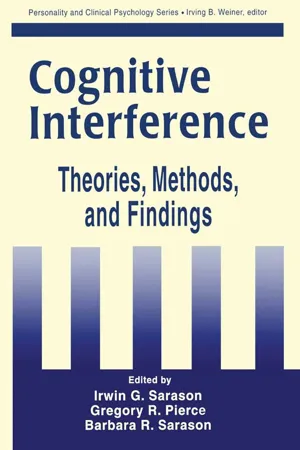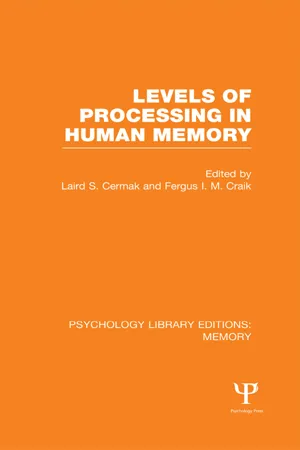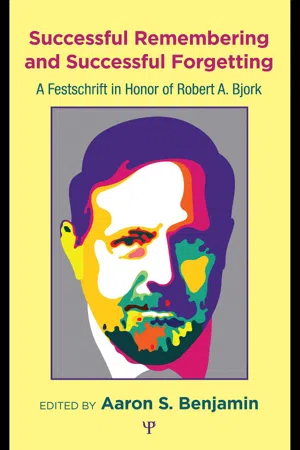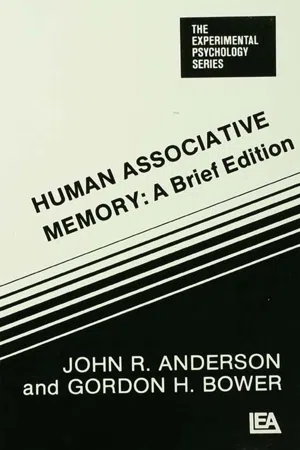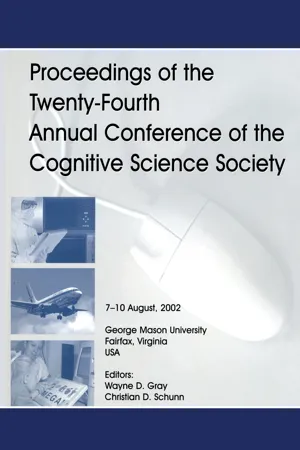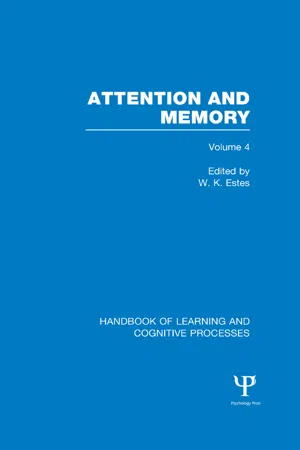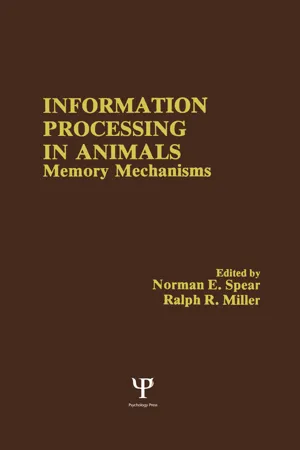Psychology
Studies on Interference
"Studies on Interference" in psychology refer to research on how the presence of competing information can disrupt memory recall and cognitive processes. This interference can occur when new information interferes with the retrieval of old information (proactive interference) or when old information interferes with the encoding of new information (retroactive interference). Understanding interference is important for improving memory and learning strategies.
Written by Perlego with AI-assistance
Related key terms
10 Key excerpts on "Studies on Interference"
- eBook - ePub
- Peter Herriot(Author)
- 2013(Publication Date)
- Psychology Press(Publisher)
Chapter 7 Past, present and future 7.1 Recent historical perspective 7.1.1 Interference theoryThe language predominantly used in experimental psychology prior to 1960 or so was that of stimuli, responses, and the learned associations between them. Memory performance was therefore seen as the product of learning — could one on a subsequent occasion produce a response to a stimulus having learned the association between the two on a previous occasion? When it became clear that there were many occasions when one could not, this fact required explanation. For, given the paradigm of learning theory, the non-availability of a response once learned is something which has to be explained. Therefore the early emphasis was on forgetting rather than remembering, and the basic technique was that of paired-associate learning.Two early concepts in the effort to explain forgetting were those of decay and interference. (For an introduction to interference theory see Cermak (1972), and for comprehensive reviews of interference theory and research see Postman (1969) and Postman and Underwood (1973).) In brief, interference theory is based upon the idea that preceding or subsequent events interfere with one’s memory of the to-be-recalled material. A typical retroactive interference design has subjects learn paired-associate list A, learn B, have a certain period of time out, recall A. A proactive design has subjects learn B, learn A, time out, recall A. Control groups have no task B.It was found that while proactive interference had the same effect whatever the time out, retroactive interference had a lesser effect after forty-eight than after five hours; that is, there was recovery (Underwood, 1948). This suggested that there was something specific about the retroactive design (in which subjects learned the interfering material after - eBook - ePub
Cognitive Interference
Theories, Methods, and Findings
- Irwin G. Sarason, Gregory R. Pierce, Barbara R. Sarason(Authors)
- 2014(Publication Date)
- Routledge(Publisher)
Psychologists have long been interested in the nature, determinants, and consequences of mental activity. Examples include William James’ (1890) focus on phenomenological aspects of mental life and Sigmund Freud&s work (1900/1953, 1901/1960, 1940) on the unconscious determinants of everyday behavior and clinical phenomena. Current research and theory on cognitive interference and distractibility can be traced to these and other early contributions in the history of psychology. One important feature of contemporary investigations of interference and distractibility is the presence of multiple paradigms from which to examine these issues. The mainstreams of cognitive and social/personality psychology in particular have each evolved rich and robust sets of programmatic and cumulative research. Not surprisingly, however, theoretical and methodological developments generated in these paradigms have not influenced trends in the other as much as they might have. The purpose of this chapter is, therefore, to encourage an integration of approaches to the topics of cognitive interference and distractibility and their influence on behavior. In order to achieve this integration, the chapter is divided into three sections. In the first section, theoretical and methodological contributions that have been inspired by research traditions in personality and social psychology, on the one hand, and cognitive psychology, on the other, are described. Because social and personality perspectives are developed elsewhere in this volume this chapter devotes proportionately less discussion to them and more to cognitive perspectives. The second section describes and evaluates two influential models of cognitive interference and performance and the third identifies needs for future research in these domains of inquiry.COGNITIVE INTERFERENCE AND DISTRACTIBILITY: THEORETICAL AND METHODOLOGICAL DISTINCTIONS
It is no accident that the title of this chapter includes the terms “cognitive interference” and “distractibility.” They represent related but different topics that have been investigated in parallel fashion by personality/social psychologists, and cognitive psychologists, respectively. Broadly speaking, in the lexicon of social/personality psychology cognitive interference refers to conscious thoughts that impede task performance; these thoughts may or may not be directly relevant to the task at hand. Distractibility, a term more frequently used by cognitive psychologists, refers more generally to decrements in performance that result from inattention to the task at hand; this inattention may be a result of either conscious or unconscious processes. Research on cognitive interference and distractibility are described separately in the following section; later in the chapter their potential integration into a more general theory of cognitive processing and task performance is discussed.Cognitive Interference
As a psychological construct, research on cognitive interference is closely linked with research on the topic of anxiety. Personality and social psychologists have identified two components of anxiety: an emotional component and a cognitive component (Liebert & Morris, 1967). Researchers have called the cognitive component of anxiety cognitive interference - Laird S. Cermak, Fergus I.M. Craik(Authors)
- 2014(Publication Date)
- Psychology Press(Publisher)
The preceding two sections have dealt primarily with concepts and research relevant to variable processing and within-individual differences with little direct relevance to our other major concern with greater interference or difficulty during original learning or processing as a possible source of facilitated delayed retention or transfer. The present section attempts to redress this imbalance by discussing the important roles of contextual interference and variety for effective memory.Until very recently, we had conceived of “intratask interference” as localized directly in the task itself and particularly in the interitem similarities or inconsistencies that lead to learning difficulty. Recent research in our laboratory, however, has indicated similar kinds of memory facilitation after very long delays for materials learned under interference produced by an additional concurrent processing task (Einstein, 1976 ), as well as showing that subjects’ processing activities may modify or even eliminate the nominal interference inherent in the task itself (Lauer, Streby, & Battig, 1976 ).Such results have led us to a broader and less direct conceptualization of functional interference including not only the interfering aspects of the task and materials but also factors extraneous to the task and inferred interference-related processing activities. Consequently, the original intratask-interference label becomes somewhat misleading and recently has been replaced by contextual interference. This latter designation seems especially appropriate in view of the important role of context in my general conceptualization of memory and the important roles of contextual factors, both within and extraneous to the subject’s memory task and processing activities, in determining what does and does not constitute functional interference.One major consequence of such an expanded view of contextual interference is to tie it closely to changes across trials in the experimental and processing contexts as potential covariates if not determinants of contextual interference. For present purposes, we will label such changes as contextual variety and suggest that increased contextual variety can produce more elaborate and distinctive processing that leads to better delayed retention, especially under changed contextual conditions at the time of retrieval. This emphasis on contextual variety as a source of improved long-term memory relates very closely to the Bransford et al. discussion of transfer-appropriate processing (Chapter 15 ). It also can be viewed as a way of overcoming encoding specificity and dependence of memory on reinstatement of the original encoding context (see Tulving, Chapter 19- eBook - ePub
- Nancy Fenton, Jessica Flitter, Jessica Flitter(Authors)
- 2015(Publication Date)
- Research & Education Association(Publisher)
Retroactive interference happens when recently learned information blocks the recall of old memories. Although Rita is a baseball fan, she has a hard time remembering last year’s World Series champion team because all she can think of is this season’s winner, which is retroactive interference.STUDY TIPMemory ConstructionBe able to differentiate between the two types of interference .• For proactive interference old information gets in the way of new information and prevents the recall of new information.• For retroactive interference new information gets in the way of old information and prevents the recall of old information.How accurate is our memory for past events? Do you remember what your third-period teacher was wearing yesterday? If you were asked ten minutes later, could you describe the person who stopped you at the mall to ask directions? Maybe, but how accurate would you be? What if the person you were asked to describe was a bank robber or a criminal who fled the scene of a crime? Often witnesses to crimes are very confident about their ability to identify criminals in lineups or give descriptions to the police, but controlled research demonstrates that we do not have as good of a memory as we believe we do. Problems with eyewitness recall have serious social and legal implications because inaccurate witness memory has led to the false imprisonment of innocent people and the acquittal of guilty suspects. Elizabeth Loftus studied the constructive nature of memory or how memory can be affected by the existing knowledge we have about similar events and how information we receive from other sources can become unknowingly added into our original memory. Loftus also investigated how the inaccuracy of human memory affects eyewitness testimony. Contrary to what many people believe, our minds do not work like video recorders that we can simply play back in order to view our memories exactly as they happened. - eBook - ePub
- Isabel Birnbaum, Elizabeth Parker(Authors)
- 2014(Publication Date)
- Psychology Press(Publisher)
Journal of Experimental Psychology: General, in press.Postman, L., & Stark, K. Role of response availability in transfer and interference. Journal of Experimental Psychology, 1969, 79, 168–177.Rand, G., & Wapner, S. Postural status as a factor in memory. Journal of Verbal Learning and Verbal Behavior, 1967, 6, 268–271.Rock, I. The role of repetition in associative learning. American Journal of Psychology, 1957, 70, 186–193.Shuell, T. J., & Keppel, G. Learning ability and retention. Journal of Educational Psychology, 1970, 61, 59–65.Strand, B. Z. Change of context and retroactive inhibition. Journal of Verbal Learning and Verbal Behavior, 1970, 9, 202–206.Tulving, E. Intratrial and intertrial retention: Notes towards a theory of free recall verbal learning. Psychological Review, 1964, 71, 219–237.Tulving, E., & Arbuckle, T. Y. Sources of intratrial interference in immediate recall of paired associates. Journal of Verbal Learning and Verbal Behavior, 1963, 1, 321–334.Tulving, E., & Osler, S. Effectiveness of retrieval cues in memory for words. Journal of Experimental Psychology, 1968, 77, 593–601.Turnage, T. W. Pre-experimental associative probability as a determinant of retention. Journal of Verbal Learning and Verbal Behavior, 1963, 2, 352–360.Underwood, B. J. Speed of learning and amount retained: A consideration of methodology. Psychological Bulletin, 1954, 51, 276–282.Underwood, B. J. Interference and forgetting. Psychological Review, 1957, 64, 49–60.Underwood, B. J. Degree of learning and the measurement of forgetting. Journal of Verbal Learning and Verbal Behavior, 1964, 3, 112–129.Underwood, B. J. Attributes of memory. Psychological Review, 1969, 76, 559–573.Underwood, B. J., & Keppel, G. Retention as a function of degree of learning and letter-sequence interference. Psychological Monographs, 1963, 77, No. 4.Underwood, B. J., Keppel, G., & Schulz, R. W. Studies of distributed practice: XXII. Some conditions which enhance retention. Journal of Experimental Psychology, 1962, 64 - eBook - ePub
Successful Remembering and Successful Forgetting
A Festschrift in Honor of Robert A. Bjork
- Aaron S. Benjamin(Author)
- 2011(Publication Date)
- Psychology Press(Publisher)
ON THE RELATIONSHIP BETWEEN INTERFERENCE AND INHIBITION IN COGNITIONMichael C. Anderson and Benjamin J. Levy
There is a moment that each of us knows all too well. This moment arises when, by chance, we encounter something that reminds us of an experience we would rather not think about. For some, this might occur when opening a drawer to see an object given to us by a loved one that has been lost due to death or a broken relationship. For others— such as for veterans returning from combat—existence may be an ongoing battle against their own memories, and against intrusive recollections of wartime experiences. Whatever the trigger, this moment elicits certain key experiences: an abrupt feeling of alarm and arousal, followed quickly by an effort to shut down retrieval, regain footing in our mental landscape, and redirect attention to more profitable goals. Even neutral memories can be too accessible; anyone who has ever gone to yesterday’s parking spot, used an outdated bank code, or called out to one’s previous spouse instead of one’s current one knows well the trouble such interloping knowledge can induce. Thus, one of the most innocent assumptions one might make about memory—that remembering is good and forgetting is bad—is, in fact, often untrue. More often than we realize, forgetting is our goal, and remembering is the human frailty.Given that forgetting can at times be a positive goal, it becomes important to address how we accomplish it, when successful. Although there are likely to be a variety of ways people limit the accessibility of unwanted memories, there has been considerable emphasis on the role of inhibition in accomplishing this function. Inhibition refers to a hypothesized control mechanism that reduces the level of activation associated with a trace, rendering it less accessible to ongoing cognition. The existence of inhibitory processes has been hypothesized in many different domains of human cognition, including attention, memory, language, and motor action (see Dagenbach & Carr, 1994; Dempster & Brainerd, 1995; Gorfein & MacLeod, 2007). In memory research, the inhibition view hypothesizes that when the activation associated with a trace is disruptive, inhibition may be engaged to reduce this unwanted accessibility. The persistence of this inhibition is thought to induce forgetting. Thus, inhibition may be one instrumental process in achieving adaptive or functional forgetting - eBook - ePub
- John R. Anderson, G. H. Bower(Authors)
- 2013(Publication Date)
- Psychology Press(Publisher)
10INTERFERENCE AND FORGETTING
Interference theory occupies an unchallenged position as the major significant analysis of the process of forgetting.–Leo Postman10.1. FORGETTING IN HAM
A fault found in most of the current stock of computer simulations of human memory is that they have forgotten that people forget. In the few programs that do forget (e.g., Reitman, 1965), information loss is viewed as simple decay of the strength of past memories. The research on EPAM and SAL (Feigenbaum, 1963, 1970; Hintzman, 1968; Simon & Feigenbaum, 1964) has been the only attempt to produce simulation models that make contact with the basic facts of forgetting from long-term memory. However, these conceptions of memory are not adequate for the task of expressing the propositional character of memory.In contrast, experimental psychologists have developed an impressive body of data and theory surrounding the process of forgetting. This, the work of the interference theorists, has been the major substantive accomplishment of American associationism. However, these efforts suffer from difficulties similar to those of EPAM and SAL. That is, the interference research has been conducted within the framework of an inadequate conception of the character of human memory. The basic unit of knowledge has pretty much still been taken to be the S-R habit, undifferentiated according to the relations among the terms; human knowledge is equated with just a list of habits. Recent papers by Underwood (1969) and Wickens (1970) recognize several different “attributes” of memories but do not go beyond cataloging some of the evidence that people can remember all sorts of things about past events. What is lacking in these efforts is an attempt to characterize the associative organization of long-term memory and how the “mind” brings that to bear in recording new facts and events, while forgetting others. Another aspect that has been conspicuously lacking is the study of interference and forgetting of sentences and textual materials. Interference theorists are probably uncomfortable analyzing the learning and forgetting of propositional materials because they have not developed any viable ideas regarding the structure of sentences (they are obviously not serial lists of words), nor any specific ideas regarding how the person brings his cognitive equipment to bear upon comprehending, storing, retrieving, and using propositional information. - Wayne D. Gray, Christian D. Schunn(Authors)
- 2019(Publication Date)
- Routledge(Publisher)
Integrating Decay and Interference: A New Look at an Old InteractionErik M. Altmann ([email protected] )Department of Psychology Michigan State University East Lansing, MI 48824Christian D. Schunn ([email protected] )Learning Research & Development Center University of Pittsburgh Pittsburgh, PA 15260Abstract
An old but important debate about human memory concerns whether decay (indexed by time) or interference (indexed by amount of distracting information) is the cause of forgetting. We argue, based on a simple functional analysis, that this is a false dichotomy. Both processes must be at work, in that distracting information must decay to allow the cognitive system to have any hope of retrieving target information amidst the unavoidable clutter of a well-stocked memory. This analysis predicts that subtle decay effects should be pervasive, even in data produced by interference theorists to show that decay was impossible. A re-analysis of data from Waugh and Norman (1965) does indeed reveal decay effects that were dismissed by the authors as inconsequential and have been ignored by most investigators since. We fit a formal model integrating decay and interference to the Waugh and Norman data, and to the decay data of Peterson and Peterson (1959) to show that one model provides an improved account of two ostensibly divergent data sets.Introduction
“Decay must be one of the most discredited theories in psychology, amongst many distinguished competitors.” — Memory researcher Robert Bjork, Michigan State University, Sept. 27, 2000.How is information lost from human memory? Of the many potential metaphors, the two main competitors have historically been decay (a process indexed by time) and interference (a process indexed by the amount of distracting information “cluttering up” the mental desktop).Of these two metaphors, decay has been the less popular, as the quotation above suggests. Memory researchers have often simply not wanted to credit the idea that memory could deteriorate by a time-indexed biological process (e.g., Keppel & Underwood, 1962; McGeoch & Irion, 1952; Postman, 1971; Waugh & Norman, 1965). Evidence often cited against decay includes the slowdown of forgetting during sleep (e.g., Ekstrand, 1972), though to interpret this slowdown as evidence against decay one must assume that the decay rate is the same during sleep as during wakefulness. Given the controversial nature of what little we do understand about brain activity during sleep, it seems equally likely that the decay rate is different in different states of consciousness. Another argument against decay is based on the observation that time by itself cannot be causal. As famously put by McGeogh, “In time, iron may rust and men grow old, but the rusting and the aging are understood in terms of the chemical and other events which occur in time, not in terms of time itself (McGeogh & Irion, 1952, p. 402). Today, many important memory theories exclude decay (e.g., Gillund & Shiffrin, 1984; Hintzman, 1988; Murdock, 1992), and cognitive textbooks often present decay theory as a historical footnote rather than as an active hypothesis (e.g., Ashcraft, 2002; Galotti, 1999; Reed, 2000.)- eBook - ePub
Handbook of Learning and Cognitive Processes (Volume 4)
Attention and Memory
- William Estes(Author)
- 2014(Publication Date)
- Psychology Press(Publisher)
Furthermore, the time period of consolidation across a variety of physiological studies varies substantially: from seconds to hours or days depending upon the conditions and the nature and strength of the amnesic agent. Such variability seems more consistent with the hypothesis of a reduction in trace fragility. Certainly a strong cast can be made (for example, Weiskrantz, 1966) that the physiological studies support some hypothesis in which consolidation takes place at a decreasing rate over the entire lifetime of a memory trace (rather than being completed in a short period of time on the order of seconds, minutes, or hours).Finally, a study of hemispheric conflict and the forgetting of lateralized traces by Goldowitz, Buresova, and Bures (1973) also supports the hypothesis of consolidation as decreasing fragility of traces (see Wickelgren, 1974a, for a more detailed discussion).II. INTERFERENCE
The hypothesis that a considerable portion of forgetting is due to interference between different learning or other information processing activities is about as old as the scientific study of human learning and memory. Sometimes, it is implied that there is “an” interference theory. Actually, there are a large variety of different interference theories. The best way to describe all the possible interference theories available at present is to list the six different interference mechanisms that have been suggested. Any combination of these mechanisms constitutes a different theory of interference though not all combinations have been advocated. Of course, there are also a variety of different ways to formulate each of these six interference mechanisms, leading to an enormous variety of different possible interference theories. The six different interference mechanisms can be given the mnemonic labels: competition, unlearning, blocking, response suppression, associative suppression, and acid bath. Each of these interference mechanisms will be defined, along with the evidence for or against each one as a contributor to retention failure.A. Competition
In a conventional paired-associates recall experiment, a subject is forced to give a single response to each stimulus. If the subject learns an A–B list followed by an A–C list (A–B, A–C paradigm) and then is given a recall test for the first list, a subject might well recall both the B and C associates to the A stimulus, but not recall which associate occurred on the first list and which occurred on the second list. That is to say, even if the subject had perfect memory for the A–B association, he might fail to answer correctly because he had imperfect memory for list membership. Experiments on list differentiation indicate that subjects forget list membership over time just as they forget anything else. Furthermore, it is possible in some instances that subjects did not learn to differentiate the lists to any very high degree at the time of initial acquisition. Whenever list differentiation is imperfect, competition is a logically necessary source of interference in a conventional recall test. Although list identification of B and C responses in an A–B , A–C paradigm is rather good, it is usually less than perfect even at short retention intervals, and declines progressively with increasing delay. For example, Koppenaal (1963) found list identification to decline from 96 to 88% correct over a period from one minute to one week following A–C learning, and Birnbaum (1965) found a decline from 99 to 78% over a period from 3 min to 1 week following A–C - eBook - ePub
Information Processing in Animals
Memory Mechanisms
- N. E. Spear, R. R. Miller(Authors)
- 2014(Publication Date)
- Psychology Press(Publisher)
More pertinent to the present chapter is the second point to be considered about these treatments: What are the full consequences of treatments that alleviate forgetting? This question contains several parts. For instance; What are the physiological mechanisms that mediate these effects? (we do not know); or; Is the alleviated forgetting only apparent and the enhanced performance merely an artifact induced by the treatment? (no, at least not in most cases; see Miller & Springer, 1974; Spear, 1973, 1976). The component of this question most relevant here, however, is whether or not the characteristics of the memory change as a consequence of this treatment. That the answer clearly can be affirmative is shown, for example, by Gordon (this volume). It is this factor, I suggest, that has special significance for understanding the relationship between memory storage and memory retrieval.For proper perspective, however, it is well to remember that a memory made more accessible through such a treatment can be shown to influence the animal’s behavior dramatically in circumstances not previously encountered and yet scarcely be altered in many characteristics when reaccessed at a later time. The example I have in mind concerns forgetting induced by retroactive interference from a conflicting memory. Suppose that an animal first acquires memory A and then conflicting memory B, the expression of which is incompatible with that of A. In this case, B weakens or eliminates the immediate tendency to express A. Is this because the animal’s representation of A is permanently lost or distorted in storage? That the answer is “no” is shown not only by experiments with pigeons (Thomas, this volume) but also in the following experiments with rats.Maintained Integrity of a Memory Subjected to Retroactive Interference after It Is Retrieved
We trained rats on two consecutive avoidance tasks in a simple, two-compartment (one black, one white) apparatus. The tasks had a great deal in common. For instance, trials began exactly the same way, with the animal placed in the white compartment followed by the opening of the door to the black compartment. But the response requirements for the first task were exactly contrary to those of the second. To learn the first task the animal had to perform a “passive avoidance” and remain in the white side; if it stepped into the black compartment, a footshock was delivered. The second task, an “active avoidance,” required that the animal move from the white to the black compartment within five seconds to avoid a footshock in the white compartment (no shock was delivered in the black compartment). Except for the response-shock contingencies, treatment was the same during the two learning tasks and the retention test. The retention test began with the animal placed in a white compartment in exactly the same manner as in each of the avoidance tasks, but with no shock delivered anywhere. We have worked with this task for a number of years (Spear, 1971) and have a pretty good understanding of its controlling parameters. We know that the following phenomena can be expected with the training parameters we applied in the present experiments: (1) a good deal of negative transfer (slowed escape speeds) occurs on the first active avoidance trial following passive avoidance learning, indicating an active memory for passive avoidance through its maintenance or retrieval, but is nonexistant thereafter and has no influence on rate of learning active avoidance; (2) immediately after active avoidance training the animal behaves little differently than if it had learned only active avoidance; (3) twenty-four hours later (or even an hour or so later) the animal is about as likely to exhibit passive-avoidance behavior as active- avoidance behavior on any particular trial; this presumably indicates a conflict between the two acquired memories.
Index pages curate the most relevant extracts from our library of academic textbooks. They’ve been created using an in-house natural language model (NLM), each adding context and meaning to key research topics.

